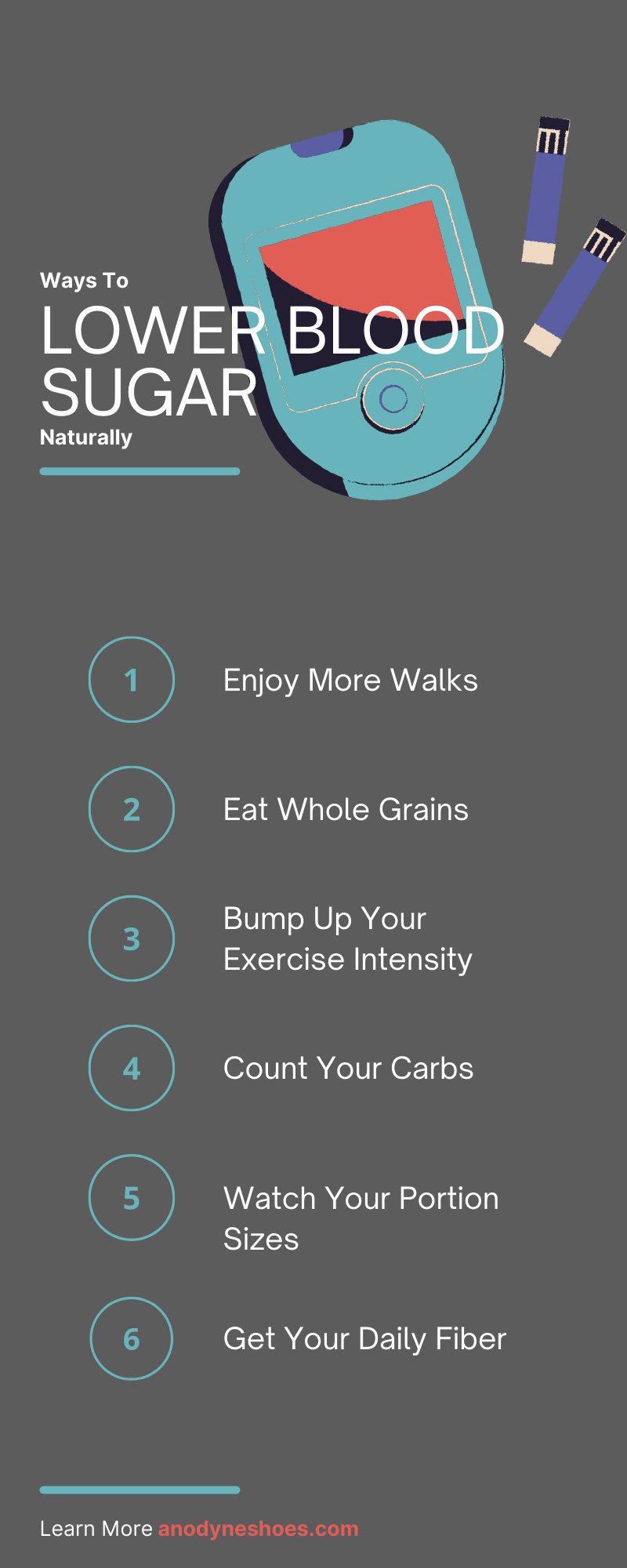%20(750%20x%20422%20px)%20(8).jpg?width=750&height=423&name=Anodyne%20Blog%20Template%20(1080%20x%201080%20px)%20(750%20x%20422%20px)%20(8).jpg)
As a person with diabetes, managing your blood sugar is extremely important. While medications like Metformin are exceptional at what they do, going the pharmaceutical route is only supplementary to a healthy, active, and balanced lifestyle for many. So, what are the best ways to lower your blood sugar naturally? Learn more about what you can do to lower your blood sugar below.
Enjoy More Walks
A sedentary lifestyle can contribute to serious increases in your weight and body fat percentage while also decreasing muscle mass. A sedentary lifestyle can slow down metabolism and heighten an individual’s insulin resistance, leading to Type 2 diabetes. Because of this, you need to look for opportunities to keep your body moving. It’s a great idea to start walking and exercising daily!
Eat Whole Grains
Despite what you have previously heard, whole grains are extremely healthy and are a great source of daily nutrients. Whole grains are packed with fiber, which helps lower cholesterol. Fiber also slows the digestion and absorption of carbohydrates, which helps maintain balanced blood sugar levels. A few of our favorite heart-healthy whole grains include barley, brown rice, oatmeal and quinoa. To give perspective, one small cup of barley contains around 7 grams of fiber, which can help mitigate blood sugar spikes. Toss it in a soup or use it as a side to progress on your health and wellness journey.
Bump Up Your Exercise Intensity
As with everything else on this list, you should consult your doctor before making any drastic changes to your lifestyle. Ensure you aren’t upping your intensity without looping in your healthcare team. Professionals can support you and ensure you exercise safely.
As you increase the intensity of your workouts, remember that it’s a marathon, not a sprint. Start by slowly increasing how many days you’ll exercise—with your doctor’s consent. Also, make sure you have the footwear to match. If you’re going to increase the intensity of your exercise, you’ll need to invest in diabetic sneakers. Now, if you are going for a hike, make sure to have diabetic boots for women and men to protect your feet on your fitness journey.
Count Your Carbs
The number of carbs you’ll want to get in your diet per meal will differ for each individual, so consult your doctor about any potential changes. The CDC recommends that people with diabetes limit their carb intake to 200-250 grams a day.
Keep in mind that carbs aren’t necessarily just found in conventional foods like pasta, potatoes, and bread. Sweets, fruits, and veggies also have carbs, which your body needs to function and thrive.
Watch Your Portion Sizes
One way to make eating in moderation easier is practicing the plate trick. If you want to watch your portion sizes without thinking about it, invest in smaller plates—you may find that you’ll eat smaller portions. Additionally, rather than completely cutting out junk food cold turkey, try to lessen the amount you eat each week and leave room for hiccups.
Get Your Daily Fiber
Regarding diabetes, fiber has one rule: the more, the better! As we mentioned above, fiber can help you moderate your blood sugar and also manage your weight properly. Additionally, increasing your fiber intake decreases the risk of cardiovascular disease. High-fiber diets can also prevent type 2 diabetes, so if you’re pre-diabetic, focusing on your fiber intake can help tremendously. Fibrous plants come in all shapes and sizes, from peas and whole grains to raspberries. Beans, an excellent source of protein, are also a fantastic source of fiber. Lentils and chickpeas may also lower your A1C, which measures your blood glucose levels over three months.
Go To Sleep
A healthy adult needs seven to eight hours of sleep per night. As it turns out, lack of sleep increases the risk of type 2 diabetes. People who sleep less tend to have higher levels of fatty acids in their bloodstream. This factor heightens insulin resistance and, as a result, blood sugar. Sleep helps regulate blood sugar, so don’t miss out on it. Get your eight hours each night—your body will thank you.
Drink Water Often
Staying hydrated is a top contender for our ways to lower your blood sugar naturally. The more water you drink, the less likely you are to have high blood sugar.
Try To Stress Less
When you’re stressed, your blood pressure isn’t the only thing that rises: your blood sugar also rises. Insulin levels fall, your liver releases glucose, and your hormones rise. The glucose goes to the bloodstream, causing blood sugar spikes for up to eight hours. These reactions make stress management integral to lowering your blood sugar. There are many short-term and long-term methods of lowering your stress; you can try tai chi and meditation or incorporate deep breathing exercises and restful naps. Many methods are available to decrease stress and keep your blood sugar within reasonable levels.
Avoid Skipping Breakfast
Breakfast is undeniably an incredibly important meal, but how many of us rush out of the door without stopping to eat before work? We’ve all been there, but it’s important not to succumb to the temptation of skipping breakfast, even when you’re in a hurry. Hypoglycemia occurs when you fast for too long, which is why it’s so important to eat on a consistent basis. Use breakfast as an opportunity to enjoy some protein and carbs to give yourself energy for the day.
Diabetes is a difficult condition to deal with. That said, it’s easily manageable when you take the proper steps and make certain lifestyle changes. A large part of making those changes involves having the right tools to succeed. We carry an amazing selection of shoes here at Anodyne to ensure your journey is as comfortable as possible. Shop Anodyne today to browse a vast footwear collection that can help you stay active and keep your blood sugar low!


.png?width=116&name=Anodyne_circle_1_logo%20(2).png)
